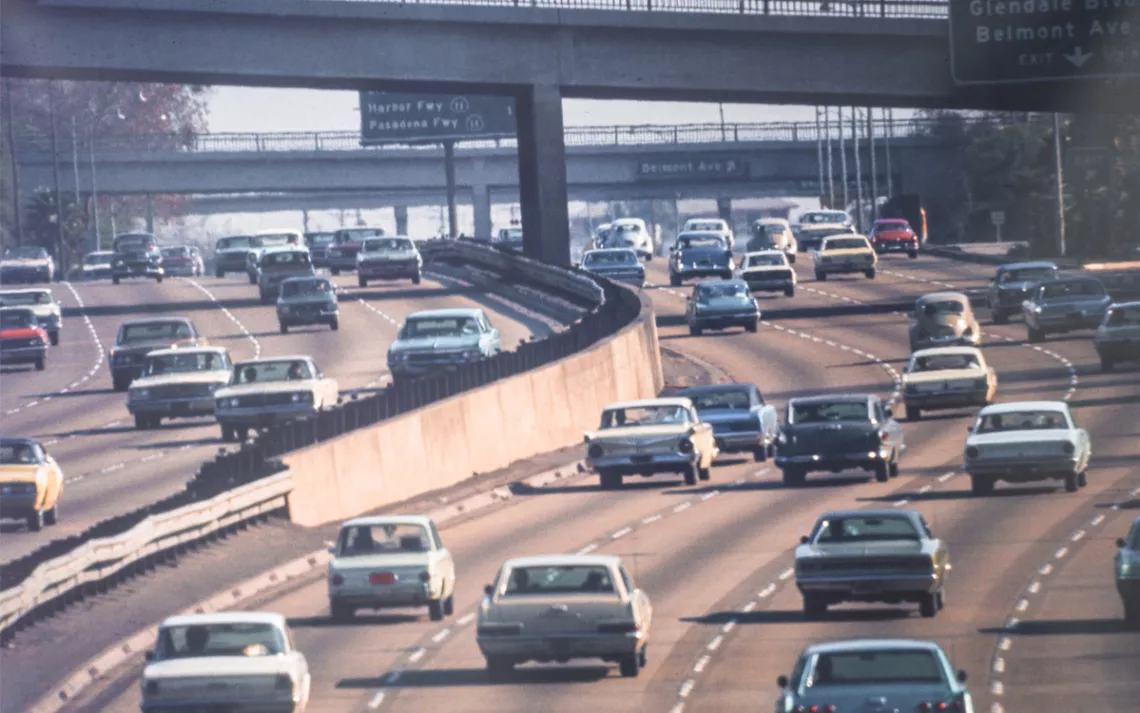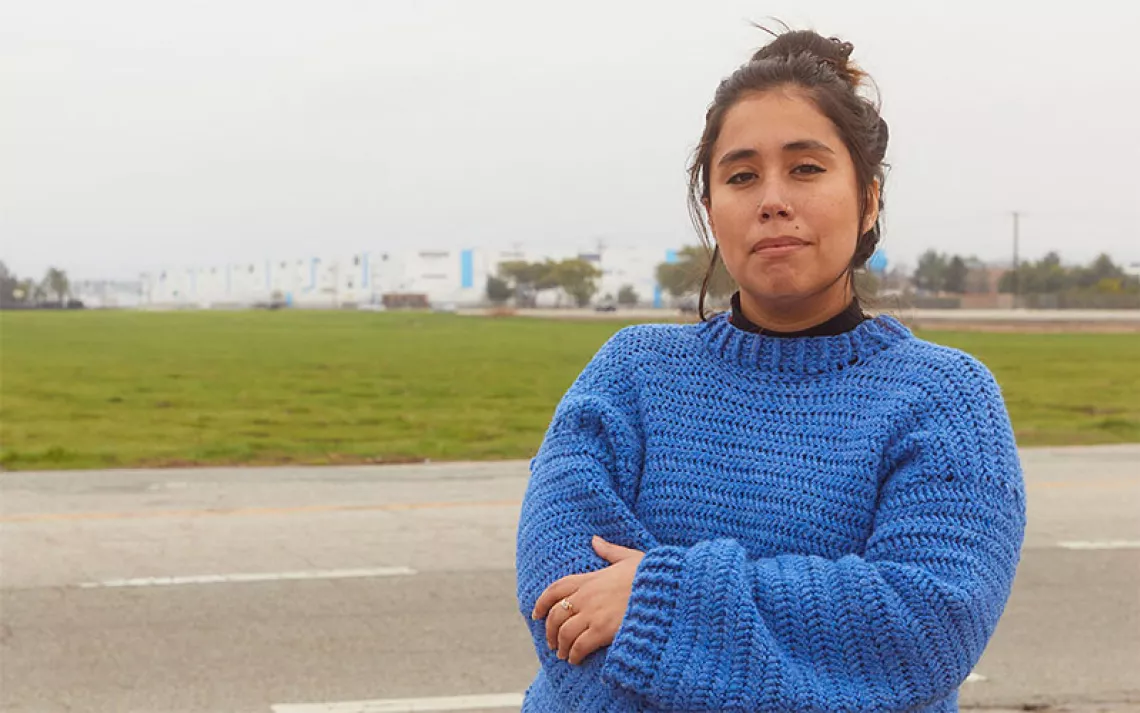LA’s Battle Against Smog Isn’t Over
In order to finally clear the air, Los Angeles needs to stop burning fossil fuels

A busy eight-lane highway in Los Angeles in the 1950s. | Photo by Jorge Villalba/iStock
Returning home from a month-long road trip in the doldrums of summer, I drove into LA's San Fernando Valley. The temperature was pushing well past 100°F; the Air Quality Index had risen alongside it, to over 200. Unhealthy for everyone. There appeared to be smoke in the air, even though nothing obvious was burning: no wildfires, no five-alarm building fires nearby. As I headed deeper into the brown haze that hovered over the valley, I felt like I was piloting a vessel into the maw of the apocalypse. No city I'd been to, not even notoriously polluted Salt Lake City or Denver, looked this dirty.
I reached for my asthma inhaler, which had been stashed in my purse for weeks. I'd had the car's AC on Recirc since the Central Valley, where the ammonia fumes of cattle operations always sting my eyes. I took a puff as a precaution. Better, I thought, to stay ahead of the pain.
If everything is electrified, we might get back LA's prized early-20th-century air.
It was worse 50 years ago, the old-timers recall. "The air used to give us all instant headaches," they say, and, "There were some days when the smog was so bad, you couldn't see all the way down the block." A friend who grew up in LA remembers, as a middle schooler in the 1970s, not being able to see the San Gabriel Mountains, the steep range to the north and east of the Los Angeles Basin. After recess, classrooms would be full of coughing children. Throats were sore; chests ached.
To be fair, Southern California's geography makes it singularly prone to smog. The mountains trap pollution in the Los Angeles Basin, and seasonal transitions called inversions—in which a layer of warmer air acts like a lid, holding colder, smoggy air close to the ground—contribute to the region's pollution woes. LA experienced its first lingering smog event in 1943, when a midsummer cloud of chemical exhaust redolent of chlorine settled over downtown Los Angeles and visibility was reduced to three city blocks. The toxic cloud was so extreme, some people believed that the Japanese military was engaging in chemical warfare.
City officials responded by shutting down a plant that produced butadiene, a chemical used in synthetic rubber, then essential to the war effort. It made little difference, because the real problem then—and now—was automobile exhaust. As Caltech chemist Arie Haagen-Smit wrote in 1970, "The search for the origin of hydrocarbons in the air over Los Angeles led to the discovery that the combustion in the automobile engine was not as complete as the industry had assumed."
It was Haagen-Smit who proved that tailpipe emissions of carbon monoxide and unburned gasoline were poisoning the air. Caltech researchers discovered that motor vehicles also release nitrogen, which turns to ozone when mixed with oxygen and sunlight. Once I learned about ozone, I could detect it in the air—a scent like the breeze before lightning strikes, or a spilled bucket of chlorine bleach.
Landmark regulations followed, stripping the lead out of gasoline and setting manufacturer quotas for zero-emission vehicles. All helped, but none have been sufficient to reduce air contaminants to levels the EPA deems healthy. It seems the problem is always running ahead of the solution. What would it take to truly clean up Southern California's air?
Adrian Martinez, an attorney with Earthjustice (his Twitter handle is @LASmogGuy), told me that about a decade ago, the South Coast Air Quality Management District met with a coalition of clean-air advocates to talk solutions. "They looked at ozone, fine particulate matter, and greenhouse gas emissions," he said. Most people assumed that climate standards would be the hardest to meet. "But it was actually not that," Martinez said. "It was ozone."
It was an aha moment. Before, he said, "we had the idea that you could make a diesel truck cleaner or make trucks run on natural gas or put a scrubber on a piece of industrial equipment." But "incrementally cleaner combustion wasn't working." In order to actually solve Southern California's air pollution crisis, people would have to stop burning fossil fuels altogether.
That would require not just zero-emission vehicles but zero-emission factories, ports, chemical plants, and buildings. It would mean that the trucks and cranes and forklifts at the Ports of Los Angeles and Long Beach would have to run on electricity. It would mean container ships would have to stop belching dirty bunker fuel emissions long before they reached the coast. "The ports were allowed to dramatically expand without considering the consequences," Martinez said. Now the consequences are clear, and they're intolerable.
"There is an actual standard that's safe to breathe," he said. "And currently, it isn't safe to breathe."
In December 2022, the South Coast Air Quality Management District approved a plan to meet the federal standard for ground-level ozone, which was tightened in 2015 to 70 parts per billion. Under current regulations, Southern California will reduce emissions of nitrogen oxides to 184 tons per day. To meet the federal standard by 2037, it will have to reduce them by more than two-thirds, to 60 tons per day.
That's a huge cut, and it can't be made by closing a few factories and power plants. The technology of transportation has to change. We need electric vehicles, yes, including e-bikes, but also more trains. If everything is electrified, we might get back LA's prized early-20th-century air, cooled by fresh ocean winds. On a blue-sky day, you'll be able to spot snow glinting atop distant peaks. We could put away our inhalers, let children play outside year-round, and stop contributing to the deadly heating of the earth's atmosphere.
"We don't have time to wait," Martinez said. "We need really transformative change."
 The Magazine of The Sierra Club
The Magazine of The Sierra Club



